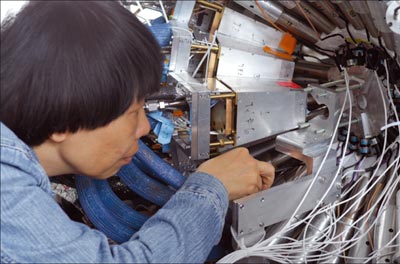By analysing collisions between several combinations of tin nuclei, researchers at the Michigan State University National Superconducting Cyclotron Laboratory (NSCL) have refined the understanding of nuclear symmetry energy. Their work marks the first successful theoretical explanation of common observables that are related to symmetry energy in heavy-ion experiments. The results should help in discerning the properties of neutron stars, particularly in the crust region.

Image credit: NSCL.
The nuclear attraction between a neutron and a proton is, on average, stronger than that between two protons or two neutrons. The nuclear contribution to the difference between the binding energy of a system of all neutrons and another with equal numbers of protons and neutrons is known as the symmetry energy. To allow for this difference, formulae to calculate nuclear masses include a symmetry-energy term. This term often takes a form that assumes the symmetry energy to be independent of density, even though its value inside the nucleus, at normal density, should exceed its value at the surface, where the density is lower and the ratio of proton to neutron densities differs from that for the nuclear interior.
The symmetry energy of a stable nucleus reflects typical nuclear densities of about 2–3 × 1014 g/cm3; it contributes modestly to the binding energy but influences significantly the stability of nuclei against beta decay. Despite the sensitivity of nuclear masses to its average value, the precise understanding of the dependence of symmetry energy on density has proved elusive, leading to large uncertainties in theoretical predictions for properties of nuclei that are very rich in neutrons. The effects of symmetry energy loom even larger in environments that have unusual ratios of protons to neutrons and much larger ranges of density, such as in neutron stars. There, the dependence of the symmetry energy upon density is one of the most uncertain parts of the mathematical palette describing the forces at play.
Now, Betty Tsang, Bill Lynch, Pawel Danielewicz and colleagues have helped to constrain understanding of the density dependency of symmetry energy by studying how it affects heavy-ion reactions at NSCL’s Coupled Cyclotron Facility (Tsang et al. 2009). In two experiments, the team directed various beams of tin nuclei at stationary targets of tin. The four combinations included a beam of 124Sn (50 protons and 74 neutrons) on a target of 124Sn, 112Sn (62 neutrons) on 112Sn, 124Sn on 112Sn, and 112Sn on 124Sn. This allowed the researchers to create and study nuclear matter with different neutron-to-proton ratios over a range of density, which could be varied by adjusting the energy of the beam and the centrality of the collisions.
The team collected data on several observables, including isospin diffusion, which probes the neutron-to-proton ratio of neutron-rich projectile nuclei after collisions with neutron-deficient target nuclei. During grazing collisions at relative velocities of 0.3 c, a neck region with reduced density can form between projectile and target nuclei through which neutrons and protons can diffuse. The stronger the symmetry energy is in this neck region, the more likely the neutron-to-proton ratios in the projectile and target nuclei will equilibrate and become equal. A second observable involves comparisons of the energy spectra of neutrons and protons in central head-on collisions. In this case the symmetry energy expels neutrons from the central overlap region of the projectile and target nuclei; the ratio of neutron-to-proton emission then provides a probe of the variation in symmetry energy as the system compresses and expands during the collision.
By comparing the experimental data to results obtained with theoretical models developed by their Chinese colleagues, YingXun Zhang and Zhuxia Li at the China Institute of Atomic Energy, the team obtained constraints on the density dependence of symmetry energy at densities ranging from normal down to around one third nuclear matter density. The results will help to describe the inner crust of neutron stars, where the density of nuclear matter is in the 1–2 × 1014 g/cm3 range. The role of symmetry energy at the cores of such stars, where the density of nuclear matter reaches 8 × 1014 g/cm3, is currently associated with the largest uncertainty in descriptions of neutron stars.
Further reading
M B Tsang et al. 2009 Phys. Rev. Lett. 102 122701.





